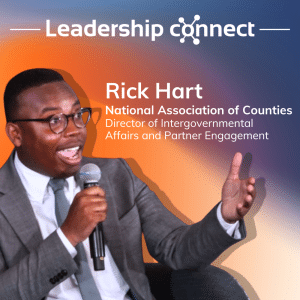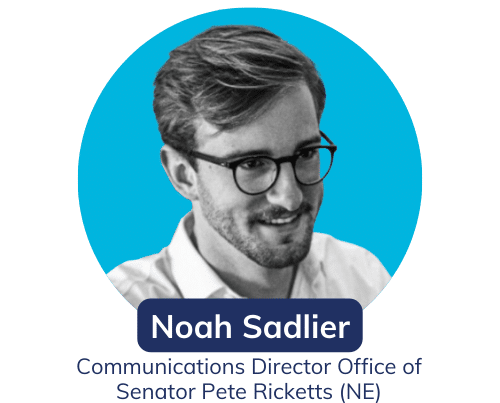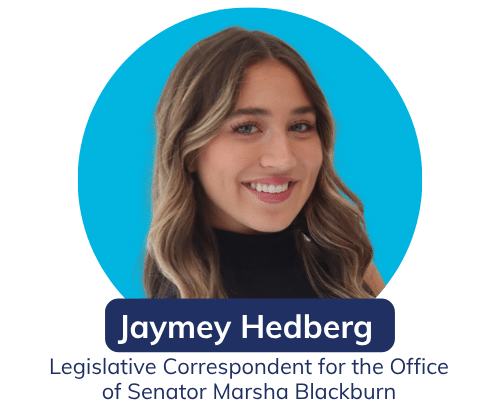by: Sarah Clein, Leadership Connect
In times of uncertainty, staying connected and informed can make all the difference. Leadership Connect’s Government Shutdown Perspectives interview series is part of our ongoing effort to provide clarity, support, and community for those navigating the challenges of the shutdown. Through thoughtful discussions with leaders across government, associations, and industry, we aim to share practical insights, personal experiences, and resources to help public-sector professionals lead with confidence and stay grounded through ongoing uncertainty.
Guiding Counties Through the Shutdown
Last week Leadership Connect’s Sarah Clein spoke with Rick Hart, Director of Intergovernmental Affairs and Partner Engagement at the National Association of Counties (NACo). Hart has been working to ensure counties have the information and support they need during the shutdown.
Can you start by telling me a bit about yourself and your role at NACo?
My role largely focuses on how the National Association of Counties can build and bolster external relationships across the board in a way that benefits counties more broadly.

I am tasked with building relationships and maintaining relationships with organizations such as our big seven intergovernmental association counterparts, whether that’s the National Governors Association or the U.S. Conference of Mayors, National League of Cities, and so on. I’m the point of contact for those organizations. I’m also the point of contact to private sector entities, to sporting associations such as the FIFA World Cup, which will take place in 12 host jurisdictions across the United States next year, along with the LA 28 Olympics, which is coming in just a few years.
We’re working with the greater LA host committee to ensure that at the federal level that they have all that they need to ensure that the games are a success. And more recently delving into building and bolstering our transatlantic relationships. We’ve just established a very fruitful partnership with the US-Japan Business Council. We’re doing some work with embassies in the greater D.C. area and I’m really excited to build out that portfolio as well. A lot falls under that umbrella, but at the end of the day, it’s really just external affairs management.
How have the functions of your role changed since the shutdown began?
Over the course of this year, since the Trump administration took office, we have seen a couple of different ways as to when and how our members and our stakeholders are using us as a resource repository. In the immediate aftermath of President Trump being sworn in, there was a flurry of executive orders that were signed. You had inter-agency partners creating new rules and regulations which were drastically different than we saw under that of the Biden administration.
At the beginning of this year, we were really the resource repository for a lot of our folks to understand what these changes would look like for them day in and day out. Flash forward to the spring, we kind of served that purpose as we were working to determine what would be the content of H.R. 1, also known as the One Big Beautiful Bill Act, that’s now law. There were a series of provisions that we lobbied for, and a series of provisions in which we fought against. I like to think that we were relatively successful in our lobbying and advocacy efforts there. Once that bill was eventually signed into law this summer, we have really become a great resource, I would argue, in ensuring that our members understand what the bill’s provisions mean for them and how they can look to implement and abide by federal law as to its contents. So, that’s been a lot of what we’ve done earlier throughout the course of this year.
Now, flash forward to being in day 17 of a federal government shutdown. We are now acting as a resource for folks to kind of understand agency by agency, how they can ensure that their critical and essential services continue to be delivered in essence by the federal government in the event that they even are. We’re helping folks navigate questions and taking inquiries each and every day to ensure that America’s 3069 counties have answers with regards to what they can and aren’t able to do in the midst of a federal government shutdown.
How has NACo adapted its communications during the shutdown, such as newsletters, webinars, or direct outreach?
We’ve put together a very comprehensive FAQ and primer. It goes agency by agency, detailing continuity plans, contingency plans for all federal agencies in which federal funding has been impacted by the shutdown.
In the lead up to the passage and signage of the One Big Beautiful Bill, also known as H.R. 1, we instituted what we call an Inside Washington series that takes place bi-weekly. Those are calls with anyone that is an NACo member can join. Those calls take place on Thursday afternoons. Our most recent one was just yesterday. And over the course of the last few weeks, those calls have shifted from being more about agency rulemaking and things of that nature, executive orders, H.R. 1 implementation, they’ve really just shifted to be fixated and focused on how the shutdown is impacting counties and how we can be of help in ensuring that counties navigate the circumstances that they’re currently being presented.
Are there examples of specific counties that have shown resilience during the shutdown, perhaps drawing on lessons from previous ones?
For those of us that live and work in the greater Washington area, we are looking at a region that has more federal workers per capita than any other region in the country. So, I am thinking about Loudoun County, Virginia, along with that of Fairfax County, Arlington County, and a few others in Northern Virginia, along with Montgomery County, Prince George’s County, Charles County, Maryland, that sit kind of within that greater DC Beltway region that have produced really good online and in-person resources to assist displaced workers that are working to navigate the shutdown.
Montgomery County, Maryland has recently launched a mobile resource program for displaced federal workers that would work in tandem with federal workers that have been terminated from their positions over the course of this last year. That program intends to provide professional development skills training services along with job search assistance in the event that folks decide to leave the federal service in the midst of the shutdown and want to look to establish a career in another sector, for example. That’s taking place in Montgomery County, Maryland.
Howard County, Maryland, County Executive Calvin Ball has instituted housing assistance along with foreclosure assistance for displaced federal workers, the county is actually working to provide stipends to folks that are having financial assistance in terms of ensuring that their mortgages are paid and things of that nature. I’ve been really impressed with the development of that program over the course of the last weekend.
I recently read an article about Alameda County, California in which that particular county has made its food assistance programs available to all federal workers and their families. So, we’re really seeing in this moment of incredible difficulty, counties stepping up to lead and provide assistance to folks that are most impacted in this moment.
How are counties handling disruptions in federal-to-local programs such as staffing issues, service cutbacks, or project reprioritization?
We’re looking at a time in which counties and local governments across the board are, for lack of better terminology, strapped for cash. The One Big Beautiful Bill, H.R. 1, did shift back a lot of programs and costs that used to be supplied by the federal government to the states and cities and counties. So, we’re already looking at an era in which a lot of local government and a lot of state government is constrained as to what they’re able to fund and support and implement moving forward.
We are in the midst of budget season at the local level as well. What we’re actually seeing is in some localities as counties are working to look into reserve funds to ensure that they can continue to make payroll for critical and essential services. Some counties have been promised a distribution of federal grants and other funding needs that they have secured through the federal government that they will not see. Now they’re looking for ways to try to find additional dollars to alleviate those funding gaps. We really are at a time in which counties are a bit distressed about the way in which they’re going to be able to continue to operate at their maximum optimal capacity in the event the government does not reopen in a timely manner.
Are there new normals you foresee in how counties plan or budget to prepare for future shutdowns?
I think time will tell. I really think that we are working towards a bipartisan solution in terms of ensuring that the government is funded moving forward so that we can make our way into 2026 appropriations and pass that point to ensure that counties continue to receive the $62 billion in intergovernmental revenue that is generated from the federal government and then sent to counties for critical and essential services.
I really think time will tell to see how this all ends, hopefully very soon. And I think I could maybe get you a better answer as we work towards a hopeful resolution in a positive direction to ensure that counties have all of the funding that they need on the federal end to continue to move forward and press on.
What kinds of questions or concerns are you currently hearing most often from local leaders?
What I’m hearing pretty regularly is that folks want a breakdown agency by agency as to what programs are impacted. I’ll give you an example that is very top of mind for me considering the size and scope of the locality that I’m about to mention, which is Cook County, Illinois. I believe that’s America’s third largest county. Chicago is its county seat and also top five in terms of population within the United States in terms of our cities.
About 60 % of Cook County’s $10 billion budget is tailored towards health and human services related expenditures, meaning that Medicaid, SNAP, and other healthcare related functions are supported in large amounts by that of federal dollars. Cook County, for example, is diligently working to ensure that they have everything that they need to ensure that their hospitals and their beds and that their other health and human services related facilities have all of the federal dollars that they need.
It’s just a very, very difficult time for a lot of our stakeholders and a lot of our members to kind of navigate the circumstances at play. And again, that’s why we want to do everything that we can to ensure that the shutdown ends as quickly as possible in a bipartisan fashion.
How are local leaders currently getting the information they’d normally rely on from the federal government before the shutdown?
NACo is currently the leading resource repository in the grand scheme of things. I think there is a way, obviously, for folks to work through their member offices. You can go through your congressional member or your congressional district. You can go through your United States Senator. You can also try to work through any given committee that might be the appropriator of federal funds that you have.
Right now, with the federal government not operating at its full operating capacity, I’m not entirely sure that folks are going to be able to get that information in a timely manner. So again, I would really encourage folks to utilize our services, our publications and data that we’re producing as we’ve done an adequate job in this moment of ensuring that folks have all that they need to continue.
Once the shutdown ends, what do you expect the bounce-back to look like for counties and for NACo?
At the end of the day, one thing the counties do understand is that we have to continue to press on not going back to appropriations for the next fiscal year. Other critical needs surface; transportation is one that needs to be taken care of very quickly at the back end of the year. We’re looking at a farm bill potentially early next year, Secure Rural Schools, which is a program that allows for schools in America’s rural counties to receive critical dollars to support K-12 educational needs, that needs to be funded past the end of the year. A lot of counties are already looking for a resolution in terms of the ending of this shutdown to ensure that they can continue to move forward and compete for federal grants and the delivery of those federal dollars that are so needed moving past the shutdown itself.
What advice or recommendations would you offer to other nonprofits or associations, especially those supporting local governments, as the shutdown continues?
One thing that I think that I’ve seen that’s been a constant trend is that there is really a void in information just across the board as to how the federal government is operating any given day of the week. What I would do is encourage any association, any intergovernmental partner, any think tank, anyone that fits within that realm to look to be a resource in connecting people with the critical tools and resources to navigate this moment.
What we’re doing at NACo is actually taking a look at examples as to how counties are working to confront the shutdown head on so that we can have a long running list in the event that this takes place in any given fiscal year moving forward as to what counties did in this moment and what they can potentially look to do. Moving forward I would encourage folks to do that as well for stakeholders in their orbit.
I always am going to be the loudest and most proud champion of what we do at NACo as I’ve done a couple of times throughout this interview. If there’s any way in which you have folks in your orbit that could benefit from what we are producing, please direct them our way. They don’t necessarily have to be a county stakeholder whatsoever. That’s a large part of the reason as to why I’m in the current capacity that I’m in to ensure that folks across the board can benefit from our resources and things that we produce each and every day.
Is there anything else you would like people to understand about NACo’s role during this shutdown period and potentially afterwards as well?
One thing that I say quite regularly just in terms of sheer numbers is that NACo’s membership consists of America’s 3069 counties. In that, we represent over 40,000 county elected and appointed individuals or officials nationwide. And past that point, there are about 3.6 million people that call a county government their form of employment. With that being said, with all of the stakeholders just mentioned, we always want to remind folks as to how many people are impacted by the critical roles that county government serves.
Going back to the employment statistic alone, we’re looking at about two-and-a-half percent of America’s workforce calling the county government their employer. That’s a massive amount of people nationwide that we want to ensure that, within the federal landscape and in our conversations with state and local governments all across the board, folks understand the level and breadth of folks that we represent.
I always try to remind people of those factoids, typically these are some of the leading points that I make at the onset of a meeting. Looking forward, I will continue to be a relentless champion for the role of county governments and those that serve within counties.







